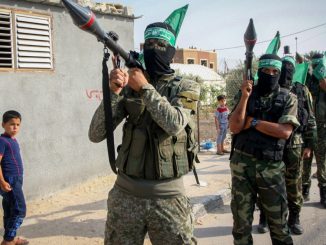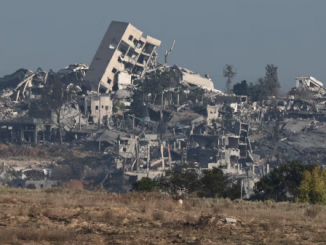
Yasser Abu Shabab can be seen holding a gun in this image posted on the Popular Forces’ Facebook page. – From Popular Forces/Facebook
| Published June 8, 2025
RAFAH, Gaza Strip — In the war-torn landscape of southern Gaza, a little-known figure has emerged at the center of a developing dynamic between Israeli forces and local Palestinian groups. Yasser Abu Shabab, a former police officer, now commands a group of armed men patrolling the ruins of Rafah. Identifying themselves as the “Popular Committees,” his unit claims to protect aid convoys, maintain order, and prevent looting—roles traditionally carried out by state or international authorities.
Wearing a mix of police and military gear, Abu Shabab’s men operate checkpoints, direct civilian traffic, and distribute aid supplies. Videos circulating online show the group in full tactical outfits, including camouflage uniforms, radios, and body armor. Abu Shabab himself has appeared in videos escorting medical shipments and asserting that his group is not affiliated with any political movement.
“We are here for the people,” he says in one clip, standing beside a delivery truck. “Our goal is to serve and protect our community.”
However, Abu Shabab’s emergence has raised questions beyond Gaza’s borders. Israeli officials have acknowledged a strategy of supporting certain Palestinian clans and groups who oppose Hamas. Prime Minister Benjamin Netanyahu recently said in a press conference, “We have activated some clans that oppose Hamas and are willing to cooperate with us.” Though he did not name specific leaders, Abu Shabab is widely believed to be among those operating with Israeli approval.
The Wall Street Journal reported that Israel has supplied Abu Shabab’s group with weapons and equipment, including rifles, vehicles, and communications gear. According to unnamed Israeli and Palestinian officials cited in the report, the support is part of a broader campaign to establish alternative power centers in Gaza following the military operations against Hamas.
In Rafah, Abu Shabab’s presence is visible. His fighters man junctions and oversee the movement of people in areas flattened by recent airstrikes. Local reactions are mixed. Some residents view the group as a stabilizing presence, while others express concern over their rapid rise and access to resources.
Humanitarian organizations have taken notice. While some acknowledge the improved flow of aid in zones controlled by Abu Shabab’s group, others remain cautious. One official, speaking anonymously, said it remains unclear who controls the distribution and whether it is being handled equitably.
Israeli military officials have not directly confirmed the identities of the armed groups receiving aid or arms but said they are seeking “localized alternatives” to Hamas governance.
Meanwhile, in public addresses and in person, Abu Shabab continues to emphasize that his group’s role is strictly humanitarian and security-focused. He has denied receiving instructions from Israeli commanders and insists that his men do not carry out military operations.
As Gaza’s landscape shifts in the aftermath of prolonged conflict, groups like the one led by Abu Shabab have become prominent players in areas left ungoverned by former authorities. Their visibility, equipment, and interaction with both local populations and outside actors signal a new chapter in the region’s complex political and security fabric.
Character Profile: Yasser Abu Shabab
Role: Leader of the “Popular Committees” in Southern Gaza
Location: Rafah, Gaza Strip
Background: Former police officer in Gaza
Affiliation: Self-described as independent; not affiliated with Hamas or Fatah
Known For:
-
Leading an armed group in Rafah involved in aid protection and civil order
-
Public appearances in tactical gear, often escorting humanitarian convoys
-
Described by Israeli and Palestinian officials as a local actor receiving support from Israel
-
Often seen directing traffic, manning checkpoints, and overseeing aid distribution
Public Statements:
-
Claims to be acting independently to protect civilians and aid routes
-
Denies being a collaborator or working under Israeli command
-
Frequently uses the phrase: “We are here for the people”
Group Name: Popular Committees
Size: Undisclosed; estimated to be several dozen armed men
Activities:
-
Operating roadblocks and checkpoints
-
Providing escort for aid trucks and medical supplies
-
Claiming to prevent looting and unrest in war-damaged zones
Notable Appearance:
-
Seen in social media videos wearing police-style vests and camouflage
-
Flanked by fighters carrying rifles and radios
Controversies:
-
Allegations of looting and controlling aid supplies
-
Accusations of receiving arms and logistical support from the Israeli military
-
Operating in a power vacuum left by the weakening of Hamas governance in southern Gaza
Here are the implications surrounding the rise of Yasser Abu Shabab and his “Popular Committees” in southern Gaza, based on the reports:
1. Israel’s Strategic Shift in Gaza Governance
Israel’s reported support for Abu Shabab’s group suggests a move toward cultivating alternative local power structures to replace or weaken Hamas. This reflects a broader strategy of fragmenting centralized Palestinian authority in Gaza, potentially creating smaller, Israel-aligned factions.
2. Fragmentation of Palestinian Authority
If multiple armed groups like Abu Shabab’s gain control over aid, security, or governance, it could further fragment Palestinian political unity. This might undermine both Hamas and the Palestinian Authority’s influence, complicating any future negotiations or peace efforts.
3. Blurred Lines Between Humanitarian and Military Roles
Abu Shabab’s dual role—both as a provider of civil services and as the head of an armed force—raises concerns among aid organizations. The militarization of humanitarian aid distribution may deter international NGOs or skew equitable access to resources.
4. Potential for Internal Conflict
Rivalries may emerge between Abu Shabab’s group and other Palestinian factions, including those loyal to Hamas or unaffiliated clans. If multiple militias vie for control, it could lead to power struggles and localized violence.
5. Reputation and Risk of “Collaboration”
Figures like Abu Shabab risk being labeled as collaborators, which carries significant danger in Palestinian society. Such a label can lead to political isolation or targeted reprisals—further destabilizing the already volatile region.
Overall Takeaway:
Yasser Abu Shabab’s rise highlights the complex reality of power, survival, and perception in Gaza’s war-torn south. To some, he appears as a pragmatic figure filling a dangerous vacuum—offering stability and aid where traditional authorities have faltered. To others, his perceived cooperation with Israel and rapid militarization raise suspicions of betrayal and exploitation. His image ultimately depends on who tells the story: a protector for some, a collaborator for others—reflecting the deep fractures and shifting allegiances within Gaza’s volatile landscape.
SOURCES: CNN – Champion of the people or a traitor? A new force emerges in southern Gaza
THE WALL STREET JOURNAL – Israel Arms Palestinian Militia to Counter Hamas
AP NEWS – Netanyahu says Israel has ‘activated’ some Palestinian clans opposed to Hamas





Be the first to comment